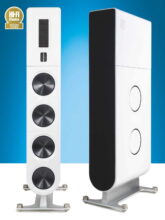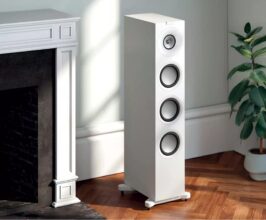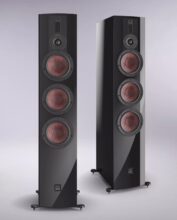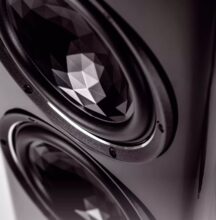Fyne Audio Vintage Twelve Review
With their Vintage Series, Fyne Audio wants to revive the HiFi spirit of the 1970s – with new technologies. The Model Twelve shows how intoxicating this spirit can be.
by Marius Dittert
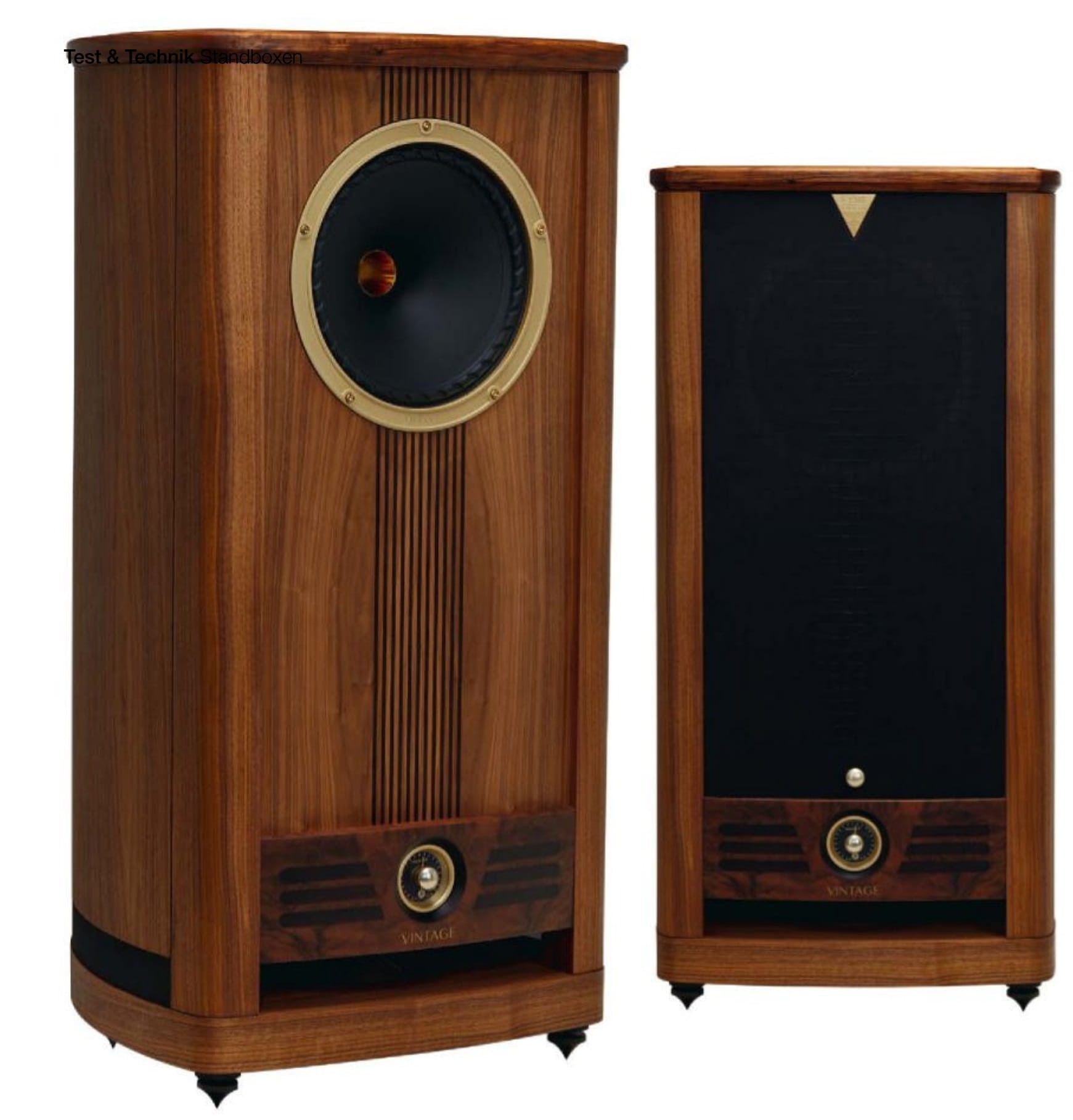
The “seventies” were flashy: long hair, bell-bottoms, platform shoes, and a colorful shirt with a big collar. That’s how not only rock stars dressed back then. And yet, they were much more than just a playground for color enthusiasts.
The 1970s were a great time for popular music. A time when fashion and music were more closely intertwined than ever before or since. The Rolling Stones, Led Zeppelin, Pink Floyd, and other bands attracted millions of young concertgoers and record buyers back then. At the same time, the audio industry experienced a unique peak, leading to legendary company foundations and many innovations, such as the transistor amplifier or direct drive.
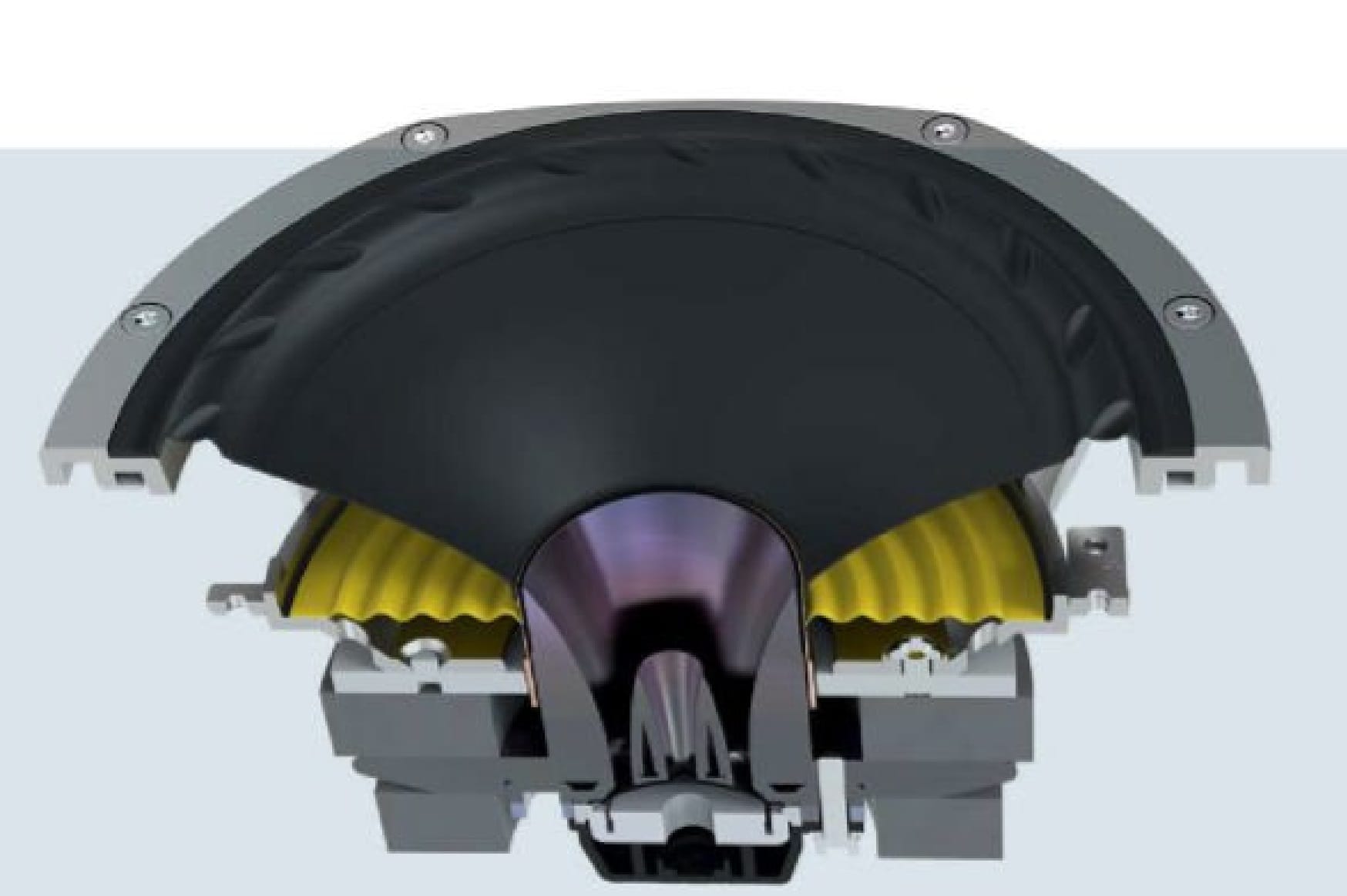
Relive the Golden HiFi Era
Fyne Audio from Bellshill southeast of Glasgow alludes directly to this “golden HiFi era” on their website. The Scottish manufacturer wants buyers of the Vintage Series to “relive the 1970s.” For the author, that would mean: the highest manufacturing quality, a design that ignores trendy lifestyle, and last but not least, a rich and room-filling sound that doesn’t have to be perfect but truly warms the musical heart.
Well suited for the country estate
Dr. Paul Mills, Technical Director of Fyne Audio, was also infected with the (incurable) HiFi virus in the seventies, like the author and surely many readers. After youthful do-it-yourself attempts, he ended up at the world’s oldest speaker manufacturer – Tannoy, where he made a name for himself over the years as Head of Development in the audio industry. The two new speaker series he created for Fyne Audio (“Vintage” and “Classic”) represent, according to the manufacturer, the culmination of his work as a loudspeaker developer.
Indeed, our test sample, costing $28,600 and weighing around 77 kilograms, is a truly majestic two-way transducer that, due to its dimensions, would be appropriately placed in the grand fireplace room of a Scottish country estate.
As impressive as the oversized broad-chested yet beautifully distinguished exterior are the material and surface qualities of the Scottish speaker: all anodized metal parts and the handcrafted birch plywood cabinet with oiled walnut veneer give the impression that they could outlast even the toughest Highland Games.
Nevertheless, one should not simply classify the internally extensively braced, mammoth-tree-stable “Twelve” in the robust-noble retro corner. That would totally undervalue the middle model of the Vintage Series. This is particularly shown by a closer look at the heart of the bass reflex box – the IsoFlare point source (sectional view on p. 42). The elaborate 12-inch driver unites the two “sacred” principles of horn and coax – always guarantors of dynamics and spatial imaging for HiFi fans. It is striking that the coax has to manage without additional bass even in such a mighty floor-standing speaker. This, in turn, explains the large diameter of the paper driver (and the “Twelve” in the product name). In its center works a compression tweeter with a 75-millimeter titanium diaphragm, driven by a rear-vented neodymium magnet.
Astonishingly Low Crossover Frequency
The large tweeter first works on the volume of the compression chamber, whose exit opening then radiates the sound into the horn of the mid-bass driver. The crossover point lies at an astonishingly low 750 Hertz. The Vintage Twelve can thus cover most of the musically important midrange with only one drive unit. However, a disadvantage of the low crossover frequency is that the mid-bass driver has to make a little more excursion due to the wide frequency spectrum it has to handle.
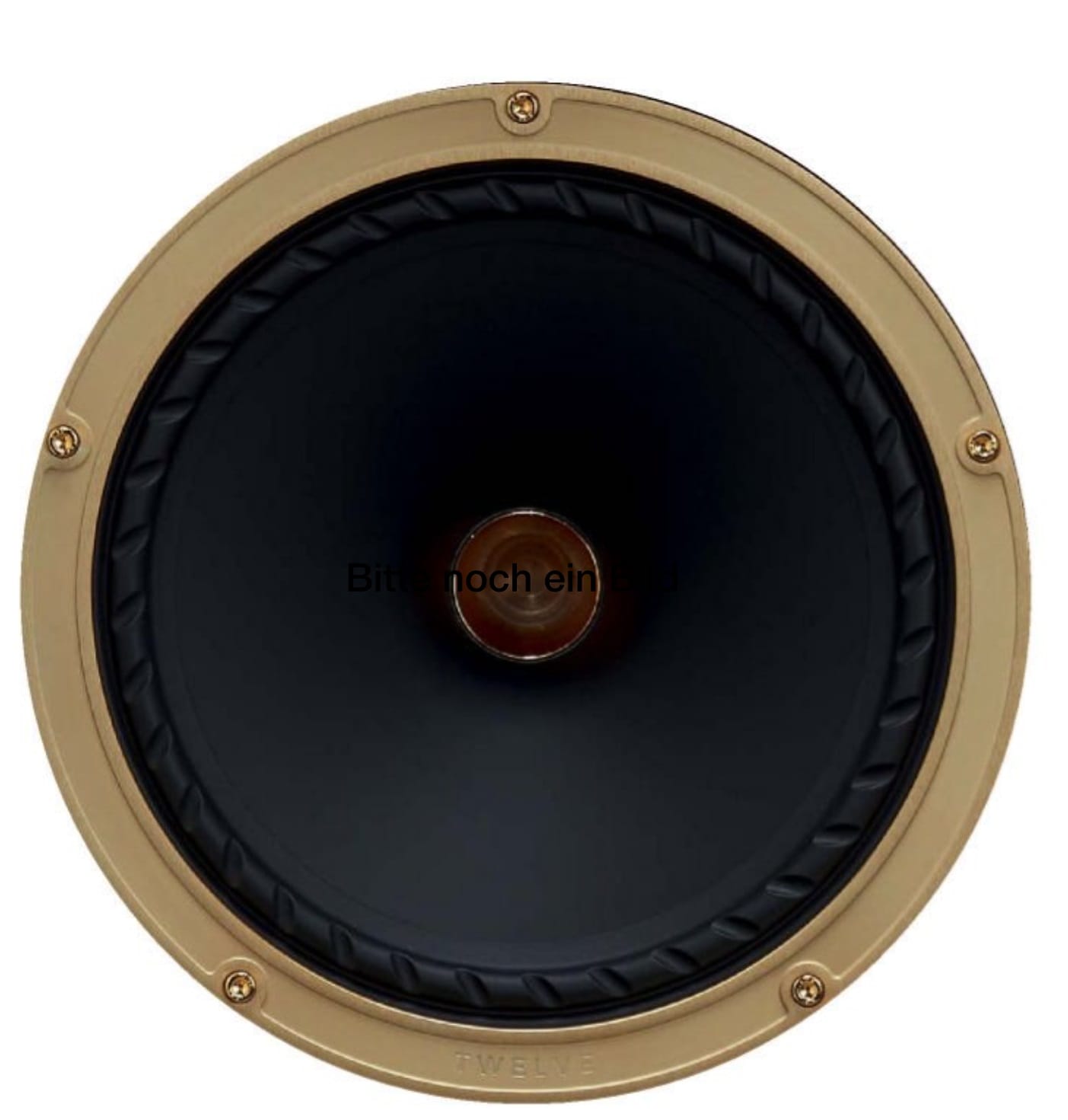
The point-to-point hand-wired second-order crossover connects the two drivers to a nominal impedance of 8 ohms and a good efficiency of just under 84 dB (2 V/1 m). The sensitivity means that music lovers can also experiment with tube amps that are not too low-powered. However, the impressive maximum level of 106 dB ideally requires 70 watts at 8 ohms.
Before the listening test, a few words about the bass reflex principle and the possibilities of room and sound adjustment: the double-chamber enclosure of the Vintage Twelve has a downward-firing reflex opening. Below the vent is a patented, tractrix-shaped diffuser that distributes the radiated energy evenly in all directions in the room. The front-side control supports gentle tuning of the presence range between 2.5 and 3.0 kHz to adjust to the listening room. On the rear side, music lovers can also sensitively adjust the treble energy. The testers decided in the damped HiFi listening room to significantly reduce the presence levels and gently raise the treble range.
Full Blast!
Anyone who wants to experience, no, feel the fascination of the Vintage Twelve down to their guts should put Nirvana’s “Smells Like Teen Spirit” (Nevermind, Geffen Records) into the player and turn the volume knob on the amplifier far to the right. What followed on the Luxman L-595A SE degraded most HiFi speakers to harmless “pussies.” Please excuse the language of the enthusiastic writer, but with the Fyne Audio Vintage Twelve, the overused phrase of “live sound” finally made sense.
After Kurt Cobain’s famous guitar intro, which stood in the listening room with the razor-sharp definition typical of coaxials, the pounding drum entry by drummer Dave Grohl followed with such force and immediacy that truly no eye remained dry. And even at levels that ear doctors would certainly not recommend, the Scottish powerhouse maintained total composure. That is to say, Nirvana’s grunge hammer sounded pure and clear at full speed like a mountain stream in the Highlands.
A similar spectacle was brought by “You Shook Me All Night Long” by AC/DC. Even as a spoiled tester, one was amazed at how the Fyne Audio managed to make an admittedly very well-done studio recording (Back In Black, Warner) sound like a live concert.
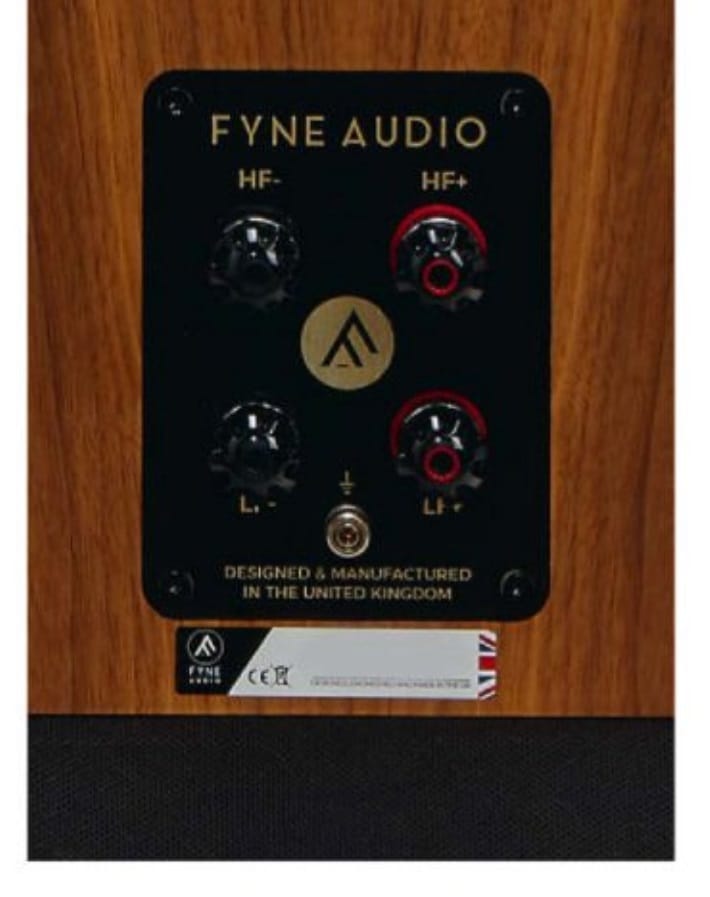
Especially impressive was how the Vintage Twelve physically placed solo instruments tangibly in the room. That also applied to classical music! The beginning of Beethoven’s 10th String Quartet (“Harp Quartet,” Opus 74) with the Alban Berg Quartet (EMI) sounded not only eerie but highly authentic in string tone.
Besides the strengths (bone-dry transients, outstanding macro- and microdynamics, fantastic resolution and imaging precision), there were also a few weaknesses to note. These would be the not optimally neutral midrange and the somewhat slim bass for a “giant box.”
Fyne Audio Vintage Twelve Performance Report
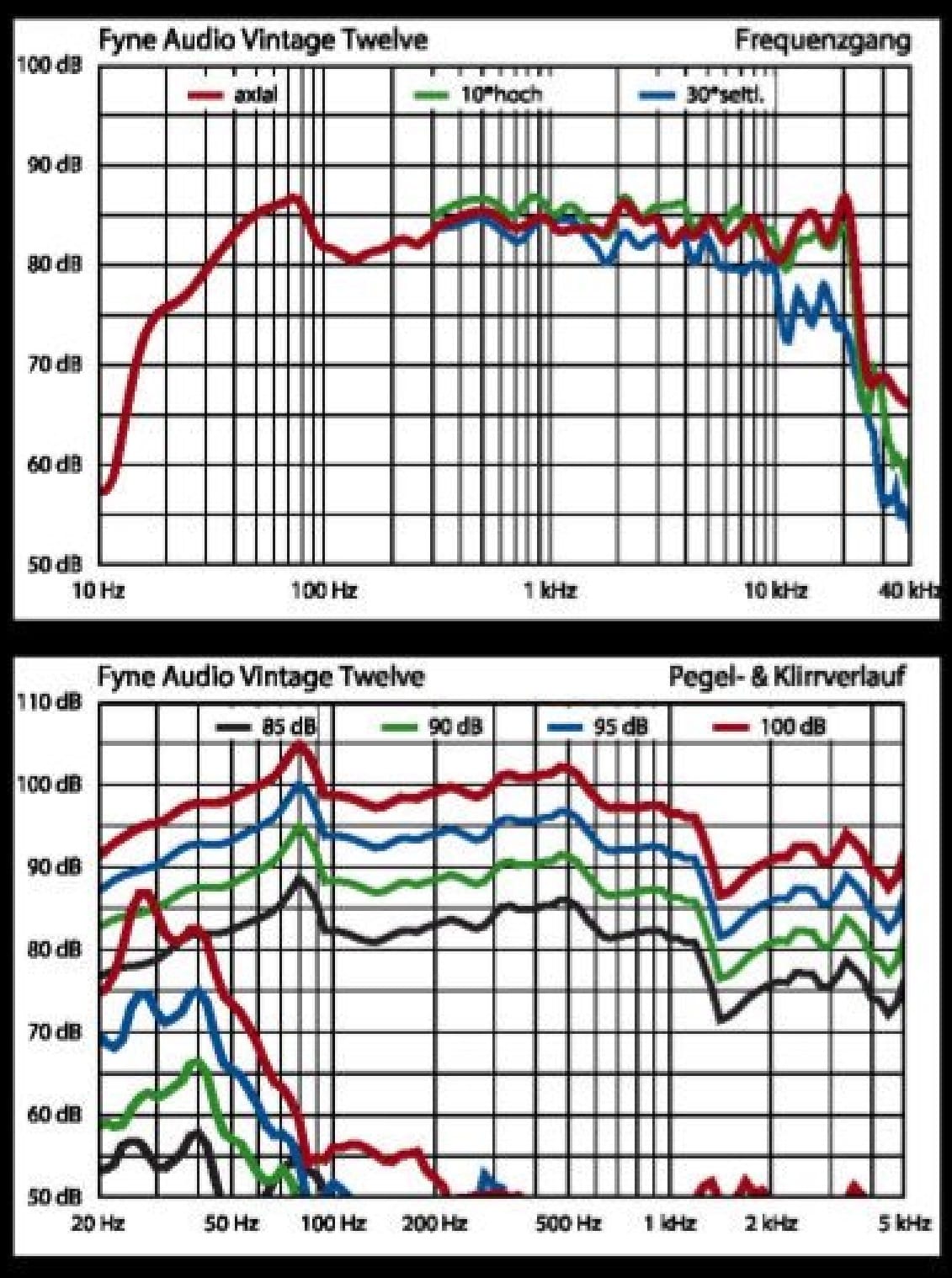
Two-way floor-standing loudspeaker with down-firing bass reflex port and high-frequency horn in coaxial arrangement. Apart from slight ripples and a lower midrange dip (4 dB), linear with homogeneous dispersion; on-axis (red) and directed 10° upwards (green), the frequency responses run almost identically. Lower cutoff frequency (–6/–3 dB) 26/33 Hz. Very low distortions at high levels, increased distortion only in the deep bass (lower diagram).
Time behavior: Delayed decay at 4, 8, 14, and 19 kHz (not shown). Maximum level in bass: 106 dB SPL. Nominal impedance: 8 Ω. Good efficiency (2 V/1 m) of 84 dB; amplifier recommendation 20–70 W/8 Ω (medium power for 100 dB SPL and maximum required power). AUDIO Score: 5.8/10
Focus on a Point
In the coaxial drive unit of the Vintage Twelve, a 75-millimeter titanium dome sits in the throat of a 30-centimeter mid-bass driver made of multi-fiber paper. Since the acoustic centers of both drivers are thus on one plane, Fyne Audio’s IsoFlare point source results in uniform dispersion with constant directivity. With correct design, the coaxial driver, which operates time-aligned without spatial offset of the drivers, produces a realistic spatial imaging with excellent depth gradation.
FYNE AUDIO VINTAGE TWELVE Specs
- List Price: 27,000 Euros
- Warranty: 7 years
- Dimensions (W × H × D): 57.2 × 110.2 × 59.1 cm
- Weight: 77.1 kg
- Finish: Veneer (Walnut)
- Design Principle: 2-way bass reflex
- Room Adaptation Features: No
- Special Features: Treble switch
CONCLUSION:
So what? Was HiFi perfect in the seventies? No, it was not!
But HiFi hit us directly in the heart back then, shook body, mind, and soul, and led to devouring record after record and virtually “beaming away” musically. Anyone seeking this great feeling and also having a penchant for music of the 70s and 80s runs a serious risk of falling deeply under the spell of Fyne Audio’s time machine. For that, after this test, the author would bet a fine bottle of single malt.
PROS & CONS
✅ Lifelike dynamics
✅ Highly stable imaging
✅ High efficiency
✅ Excellent craftsmanship
❌ Requires a large listening room (> 35 sqm)
RATING
- Neutrality: 9.7/10 (Original: 175 points)
- Detail Accuracy: 9.7/10 (Original: 175 points)
- Localization: 9.7/10 (Original: 175 points)
- Spatiality: 9.3/10 (Original: 167 points)
- Microdynamics: 9.7/10 (Original: 175 points)
- Max SPL: 10/10 (Original: 183 points)
- Bass Quality: 10/10 (Original: 183 points)
- Bass Depth: 10/10 (Original: 183 points)
- Build Quality: Outstanding
AUDIO BENCHMARK
- Overall Rating: 10/10 (177 points converted)
- Price/Performance: High-End
Vintage Audio Celebration with Fyne Audio Vintage Twelve
Dave Waters from Fyne Audio introduces the new Vintage Twelve loudspeaker which takes centre stage at our Vintage Audio ...



